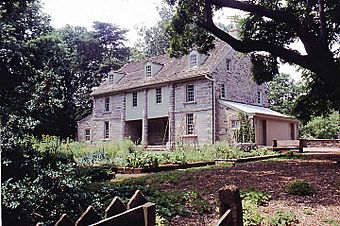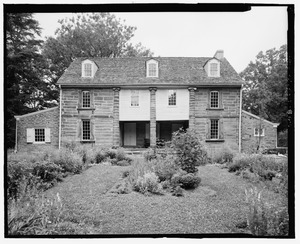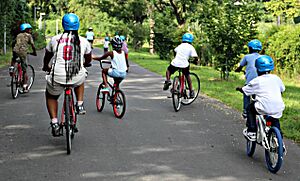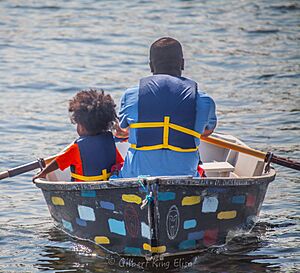Bartram's Garden facts for kids
|
John Bartram House
|
|

John Bartram's house and upper garden at Bartram's Garden
|
|
| Location | 5400 Lindbergh Blvd., Philadelphia |
|---|---|
| Built | 1728 |
| Architect | John Bartram |
| Architectural style | Colonial |
| Visitation | 100,000+ per year |
| NRHP reference No. | 66000676 |
Quick facts for kids Significant dates |
|
| Added to NRHP | October 9, 1960 |
| Designated NHL | October 9, 1960 |
Bartram's Garden is a special 50-acre public garden and a National Historic Landmark in Southwest Philadelphia, Pennsylvania. It sits right by the Schuylkill River. This amazing place was started in 1728 by a plant expert named John Bartram (1699–1777). It is the oldest botanical garden that is still around in North America! A group called the John Bartram Association helps run the Garden with Philadelphia Parks and Recreation.
Bartram's Garden is the only place where you can easily get to the Tidal Schuylkill River and its wetlands for fun. Its walking paths are even part of the East Coast Greenway, a long trail along the East Coast. The garden is like a big outdoor classroom. You can learn about plants and the history of Southwest Philadelphia here. The John Bowman Bartram Special Collections Library has many old papers and items. These tell the story of the Garden, Philadelphia, and how the study of plants grew. The garden is also a cool spot for art.
Contents
Exploring Bartram's Garden
John Bartram, a plant expert from colonial America, started this garden on his farm. His farm was in Kingsessing, west of the Schuylkill River. It was miles outside Philadelphia's city limits back then. He built his stone house between 1728 and 1731. He added a kitchen around 1740. Later, between 1758 and 1770, he added a fancy carved front to the house.
His house is still standing today. So are his first garden from around 1728 and his greenhouse from 1760. Three generations of the Bartram family kept the garden going. It became the best collection of North American plants in the world. The family sold the garden in 1850.
Today, the garden has many different kinds of plants. These include both native plants and plants from other parts of the world. Most of these plants were listed in the Bartrams' old plant catalogs from 1783 and later.
Meet the Famous Trees
The garden is home to three very special trees:
- Franklinia alatamaha (Franklin Tree): William and John Bartram, Jr. found a small group of these trees. This happened on October 1, 1765, while they were camping by Georgia's Altamaha River. William later brought seeds to the Garden. They were planted in 1777. This tree species, named after John Bartram's friend Benjamin Franklin, was last seen in the wild in 1803. All Franklinia trees growing today came from the seeds the Bartrams planted and shared. They are famous for saving this tree from disappearing forever. You can find several Franklinia trees at Bartram's Garden. The biggest one is in the Common Flower Garden, east of the Bartram House.
- Cladrastis kentukea (Yellowwood): This is a very old tree. It might have been collected by a French plant explorer named André Michaux in Tennessee in 1796. He then sent it to William Bartram. This tree is located by the Kitchen Garden, east of the Bartram House. There is another large, but younger, Yellowwood tree a bit further east.
- Ginkgo biloba (Ginkgo): This male ginkgo tree is thought to be the oldest ginkgo tree in North America. It is one of three original ginkgoes brought to the United States in 1785 from China, by way of London. You can find it east of the Bartram Barn.
A Garden's Long Story

Bartram's Garden is the oldest botanical garden still around in the United States. John Bartram (1699–1777) was a famous plant expert, explorer, and plant collector in colonial America. He started the garden in September 1728. He bought a 102-acre farm in Kingsessing Township, Philadelphia County, for his own use.
John Bartram loved plants his whole life. He turned his farm into a special collection of plants. He spent more and more time exploring. He found new plants and species in North America. He made big scientific discoveries. John Bartram also traded plants and information with other plant experts. He had a successful business selling plants across the Atlantic Ocean. By the mid-1700s, Bartram's Garden had "the most varied collection of North American plants in the world."
After the American Revolution and John Bartram's death in 1777, his sons William Bartram (1739–1823) and John Bartram Jr. (1743–1812) kept the family's plant business going. They made both the botanical garden and the plant nursery bigger. William became a respected expert in nature, an artist, and a writer. He used the garden to teach new explorers and scientists.
When Philadelphia was the temporary capital of the new nation, important visitors came to the garden. These included members of the Continental Congress in 1784 and President George Washington in 1787. Manasseh Cutler, a plant lover from Massachusetts, wrote a detailed story about his visit to the garden in 1787. William Bartram's travel book, Bartram's Travels, was published in 1791. It described his trips in the South. This book is considered a classic in American nature writing. A new version was even published in 1998.
After John Bartram Jr. passed away in 1812, his daughter Ann Bartram Carr (1779–1858) took over the farm and business. She ran it with her husband, Colonel Robert Carr (1778–1866), and later their son John Bartram Carr (1804–1839). They continued the worldwide trade of North American native plants. They shipped as many as 2,000 different kinds of plants around the globe. More people in America also wanted their plants. They even made a new garden west of the Bartram House to show off popular new flowering plants. Ann Bartram Carr was the first Bartram to open the garden to the public. She planted a half-circle, 1-acre garden for everyone to enjoy. It was a green, peaceful spot in a world that was becoming more industrial.
In 1850, the family had money problems. They sold the historic garden to Andrew M. Eastwick (1811–1879). He used it as a private park for his home. After Eastwick died in 1879, a plant expert named Thomas Meehan (1826–1901) started a plan in Philadelphia to save the garden. Charles S. Sargent from Boston, Massachusetts, who worked at the Arnold Arboretum, helped get money from all over the country. The City of Philadelphia took control of the garden in 1891. They protected it as a city park. The John Bartram Association was officially started in 1893. Their job was to take care of the garden, house, and other buildings. The garden was named a National Historic Landmark in 1960.
Sadly, between 1879 and 1891, the garden was not well cared for. Many plants were stolen, died, or were damaged. Even though some parts of the landscape disappeared, the original design that John Bartram created in the 1700s can still be seen.
The John Bowman Bartram Special Collections Library has a huge collection of papers and items about the Garden's history. A few plants in the garden today are from when the Bartram family lived there. However, there are many records about what used to grow there. This has helped with projects like bringing back the Ann Bartram Carr Garden. This is a 19th-century semi-circular garden west of the Bartram House. This part of the gardens was reopened in 2016.
In 2011, four acres along the Garden's southern edge became the Sankofa Community Farm at Bartram's Garden. This farm focuses on growing crops from the African Diaspora.
Bartram's Garden has been a living plant space for a very long time. It focuses on native plants. Its history is also connected to the area around it. This makes it a unique place to learn about plant studies and farming from the 1700s and 1800s. You can also learn about how the study of plants grew, the plant and seed business in North America, and the lives of John Bartram and his family.
Images for kids
-
Franklinia alatamaha illustration by William Bartram
See also
 In Spanish: Jardín de Bartram para niños
In Spanish: Jardín de Bartram para niños






